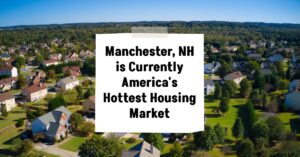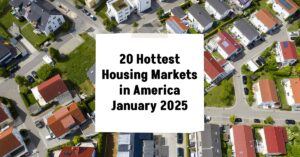Yes, you read that right! Manchester, New Hampshire, has claimed the top spot as the hottest housing market in the United States, according to the latest Realtor.com® report. This isn't just a flash in the pan; it's a testament to the city's unique appeal and the enduring qualities that are drawing homebuyers in droves. I've been watching the trends in New England real estate for years, and this surge in Manchester is something special.
Manchester, NH, is No. 1 Among America's Hottest Housing Markets
What's Making Manchester So Hot?
So, what exactly is making Manchester so attractive to buyers? It's a perfect storm of factors:
- Low Taxes: New Hampshire is known for its no income tax and no sales tax policy, which is a huge draw.
- Affordable Living (Relatively Speaking): While the median list price in Manchester was $579,000 in January, it still offers a competitive price point when compared to nearby metropolitan hubs like Boston.
- Strategic Location: A 55-mile drive will get you to Boston, meaning residents can access big city amenities without paying big city prices.
- Strong Economy: Manchester boasts a thriving local economy with opportunities in various sectors.
- Quality of Life: The area offers good schools, a strong sense of community, and plenty of options for outdoor recreation, from hiking and skiing to lakes and parks.
- Fast Sales: Homes in Manchester are selling very quickly, indicating high demand. The median time on the market was just 46 days, much faster than the national average of 73 days.
- High Buyer Interest: Listings in Manchester are getting a lot of attention online, suggesting a strong level of interest from potential buyers.
The Numbers Don't Lie: A Deeper Dive into the Data
Let's break down some of the key data points that highlight Manchester's hot market status:
- Median List Price: $579,000 in January (a nearly 4% increase from the previous month). While this is a significant price, it's important to consider the overall value proposition that Manchester offers.
- Days on Market: 46 days, significantly lower than the national median. This indicates a fast-paced market where buyers need to be ready to act quickly.
- Listing Views: Listings are getting close to four times the average views compared to the rest of the country. This is a clear indicator of high buyer interest.
- Poverty Level: New Hampshire had the lowest poverty level in the U.S. in 2023, at 7.2%, according to the U.S. Census Bureau. This speaks to the state's overall economic health and stability.
Recommended Read:
10 Best Places to Live in New Hampshire
Northeast and Midwest Still Dominate
It's interesting to note that the Northeast and Midwest continue to dominate the list of hottest housing markets. This trend has been going on for quite some time and can be attributed to several factors, including:
- Relatively Affordable Housing: Compared to coastal markets like California, housing in the Northeast and Midwest can be more affordable, especially when considering the size and quality of homes.
- Strong Local Economies: Many cities in these regions have diversified economies with opportunities in various sectors, attracting both employers and employees.
- Quality of Life: These regions often offer a good balance of urban amenities and access to nature, making them appealing to a wide range of homebuyers.
The Inventory Challenge: Why Demand Remains High
While the national inventory of homes for sale is improving, Manchester faces a unique challenge:
- Low Inventory: The area is experiencing high demand with limited availability, which is driving up prices and creating a competitive market.
- Limited Recovery: The ongoing demand has prevented inventory from recovering to pre-pandemic levels.
The Impact of Rising Interest Rates
Even with rising interest rates, the demand for homes in Manchester remains strong. While affordability is a concern for many buyers, the city's unique advantages continue to attract those who are looking for a place to call home. As Realtor.com® senior economic research analyst Hannah Jones stated, “Housing affordability continues to be a challenge for home shoppers as home prices and mortgage rates refuse to budge significantly.”
Other Cities Making Waves
Manchester isn't the only city experiencing a surge in demand. Other markets that are performing well include:
- Hartford, CT: Ranked number two, boasting a high number of listing views.
- Concord, NH: Another New Hampshire city making the list, indicating a broader trend in the state.
- Rochester, NY: Showing increased popularity.
- Boston, MA: Demonstrating resilience despite its high price point.
- Bloomington, IL: Entering the top 20 for the first time.
Why I Think Manchester's Hot Streak Will Continue
I believe Manchester's popularity will endure for several reasons:
- The Tax Advantage is a Game-Changer: The lack of income and sales tax in New Hampshire will always be a significant draw, especially for those looking to maximize their earnings.
- Location, Location, Location: Its proximity to Boston provides access to a major metropolitan area without the steep price tag.
- A Growing Sense of Community: Manchester has a unique charm and a strong sense of community that appeals to many buyers.
- The Outdoor Lifestyle: New Hampshire offers endless opportunities for outdoor recreation, attracting those who value an active lifestyle.
- Continued Economic Growth: The city's diverse economy and growing job market will continue to attract new residents.
Of course, no market is immune to fluctuations, and it's important to stay informed and consult with real estate professionals for the latest information. But based on the current trends and the underlying strengths of the city, I'm confident that Manchester will remain a highly desirable place to live for years to come.
What This Means for Buyers and Sellers
For Buyers:
- Be Prepared to Act Fast: In a market like Manchester, you need to be ready to make a decision quickly. Have your financing in place and be prepared to put in a competitive offer.
- Work with a Local Expert: A real estate agent who knows the Manchester market inside and out can be invaluable.
- Don't Be Afraid to Negotiate: While the market is hot, it's still important to negotiate and try to get the best possible price.
- Consider New Construction: With new construction offering potential incentives, this could be a viable option.
For Sellers:
- Price Your Home Strategically: Work with your agent to determine the right price for your home.
- Prepare Your Home for Sale: Make sure your home is clean, well-maintained, and staged to appeal to buyers.
- Be Ready for Multiple Offers: In a hot market, it's not uncommon to receive multiple offers.
- Consider All Offers Carefully: Don't just focus on the highest price. Consider the terms and conditions of each offer as well.
Conclusion
Manchester, NH, is No. 1 among America's Hottest Housing Markets for a reason. Its low taxes, strategic location, strong economy, and high quality of life make it an attractive destination for homebuyers from all over the country. While the market is competitive, the rewards of living in this vibrant city are well worth the effort. As someone who has been involved in real estate for a long time, I'm excited to see what the future holds for Manchester.
Work with Norada in 2025, Your Trusted Source for
Real Estate Investment in the Country
Discover high-quality, ready-to-rent properties designed to deliver consistent returns.
Contact us today to expand your real estate portfolio with confidence.
Contact our investment counselors (No Obligation):
(800) 611-3060
Recommended Read:
- Top 20 Hottest Housing Markets Predicted for 2025
- Top 10 Hottest Housing Markets Where Home Prices Are Soaring
- 5 Hottest Real Estate Markets for Buyers & Investors in 2025
- Hottest Real Estate Markets in Maine: Top Locations
- The Hottest Housing Markets in Seattle Area
- Top 10 Hottest Real Estate Markets in the World
- Hottest Housing Markets Predicted for 2024
- 68 Housing Markets Where Prices Have Doubled the Fastest














![Top 20 Hottest Housing Markets Predicted for the Next Year [2025]](https://www.noradarealestate.com/wp-content/uploads/2024/07/hottest-housing-markets-2025-300x157.jpeg)


